All Management Events
- Navigating the unknown: Modern technology’s race to the future September 28, 2019
Tech Fest 2019 dives into the hot new trends in technology with a lineup of programs like coderace, roborace, 3D printing, IoT workshops, design bootcamps, gaming development, circuit debugging, and deep learning. We explored these technologies, the future and what it holds for humanity with some of the minds behind Techfest – Neelakantam Poorna Venkat, A. Rajesh R Athimoolam, Jaswitha Reddy Guntaka, Sreya Tatineni TP Rao, and Pavan Krishna.
How do you see the future changing with the advent of new technologies?
N. Poorna Venkat: Technology will play the most prominent role in the future with tools and resources that make critical information available at our fingertips. It is fair to say that the future will be totally driven by emerging technologies and hopefully used to solve people’s daily life issues.
A. Rajesh: The advent of new technologies and applications in medicine and communication is at the core. I believe implementation of user friendly technology will continue to shape the way we live.
Jaswitha Reddy Guntaka: On the positive side, more advanced quantum computing and better security for information on the web. On the negative side, a world with zero privacy, less security and AI controlling a major part of human life. I think the protection of web content and the information on it must be given absolute importance.
Sreya Tatineni: We are at a juncture in the history of the world where marvellous new technologies come up every other day changing the course of our lives. I look forward to the future where the reality is closer to our fantasies and imagination which is virtually like we see in sci-fi – automatic cars without drivers, Delhi to NY commute in 30 minutes, colonies elsewhere in the galaxy.
According to you, which technology will be the most important in the coming 5 years?
N. Poorna Venkat: Internet of Things (IoT ) will be the most important technology in five years. It helps us connect to every man made device.
A. Rajesh: According to me, Nanogenerator technology that converts mechanical energy to electrical energy and wirelessly transfers energy to a nearby battery. Scientists from Clemson University have developed a new triboelectric nanogenerator that can generate 2000 volts of energy and transfer it wirelessly.
Pavan Krishna: Sustainable technology will be very important. We should contribute more towards natural environments rather than the technology of artificial holograms, as an example.
Which is the one thing that needs to be changed with the help of technology?
N. Poorna Venkat: Technology should be able to solve daily problems, mainly for farmers. For example, in India the weather forecast technology has to be improved.
A. Rajesh: The future use of drones in healthcare is very thought provoking. How can the industry best use this technology to improve safety and care delivery? For example, through a startup called Matternet. drones have been trained to deliver food aid and medical supplies to areas hit by disasters such as Haiti. But, while drone delivery makes it possible to courier needed vaccines to remote areas in harsh weather, it isn’t without challenges. Both blood and vaccines must be kept at a certain temperature during transport or they will be unusable when they arrive. Anyone working with the payloads must be properly trained to ensure the products arrive at the right temperature and that deliveries go smoothly.
Jaswitha Reddy Guntaka: I think climate change is an issue we can confront with the help of technology – Using simulations to show people what our world can change into in the next 50-100 years might change their perception.
Sreya Tatineni: How great would it be if there is a technology that helps us with the biggest challenge we face today namely law and order? A technology that enables faster solutions to the institutions around the world that fight crime in all forms.
Pavan Krishna: There are many things that have the scope to change with the help of technology because it all depends on that one moment where an idea culminates and transitions into implementation using existing technology, science and knowledge. If I have to be specific, I’d say converting food wastage – it should go into machines either as fuel or it should produce useful products. The machines I refer to should shrink in cost, size and effect to such an extent one can have it safely in the house
Which is your dream technology? Given a chance, which technology will you be looking forward to developing? why and how?
N. Poorna Venkat: My dream technology is one that helps farmers. We need to develop higher yield seeds or breeds that can grow in all weather conditions. This is possible only through modern technology.
A. Rajesh: I foresee a technology that can quantify the ‘feelings’ of people. Other than that, technological developments in healthcare have already saved countless lives and are regularly improving our quality of life.
Sreya Tatineni: Personally, my idea of a dream technology is the one that makes possible flying cars. It would avoid a lot of traffic congestion across the world and also prevent traffic-related catastrophes. How cool would it be to see cars flying across high-rise buildings and landing at any floor of the building as per our convenience?
Pavan Krishna: My dream technology would be Smart Vehicles which can be self-driven, traffic-adaptable (it should analyze the traffic and switch to different modes), its fuel consumption should be environmental friendly and get automatically refilled by different sources of energy?
Which technology intrigues you the most?
N. Poorna Venkat: The new technology that intrigues me is IoT, and how it can be implemented in the agricultural sector.
A. Rajesh: Voice Interface Technology intrigues me the most because voice recognition is changing the user experience and how we operate our daily lives. For example, I use Google Home every waking hour. That is what the power of a new and drastic shift in user interface and user experience can do to help users complete the simplest tasks.
Jaswitha Reddy Guntaka: The technology that intrigues me the most is AR/VR. Although I am not interested in developing it I love playing with it. I currently play Sims 4, a simulation video game.
Sreya Tatineni: As of now, it would be IoT, interrelating a variety of computing devices to transfer data across machines and living beings.
Which is your favorite book/article on technology?
N. Poorna Venkat: I basically read books related to social studies. My favorite is ‘Politics after Independence in India’. I have never actually read a book related to technology.
A. Rajesh: ‘What Technology Wants’ by Kevin Kelly is my favorite book on technology. Its focuses on human-technology relations and argues for technology as the emerging seventh kingdom of life on earth!
Jaswitha Reddy Guntaka: My favorite book on technology would be ‘Digital Fortress.’ If given a chance, I hope to develop a machine similar to the TRANSLTR.
Sreya Tatineni: One of the best ways of understanding the effect of technology on human lives is the book I read recently called “Hit Refresh” by Satya Nadella where he beautifully explains the effect of our unique human quality – empathy – in determining the course of technological advancement and its impact in changing the status quo.
Pavan Krishna: The article I can never forget is on the success of ‘Mission Mangalyaan’ where I realized that all technological advancements need not be costly and knowledge is truly timeless.
Who is the most influential person in the universe of technology and why do you think so?
N. Poorna Venkat: Dr. APJ Abdul Kalam because his hard work towards achieving his goals inspires me a lot.
A. Rajesh: John Giannandrea is the most influential person in technology. As Google’s head of search, Giannandrea is at the heart of the company’s most important business and the world’s most popular website. He’s also an artificial intelligence expert who runs Google’s A.I. efforts. His current position puts him at the juncture of search and A.I., a critical nexus for Google as it prepares for a future dominated by digital assistant software like the Google Assistant and voice-powered hardware like the Google Home rather than text-based queries.
Jaswitha Reddy Guntaka: There are many influential people in this domain of technology and Elon Musk is one of those people with whom I see eye to eye, on a few of his ideas.
Pavan Krishna: The most influential person in technology is Elon Musk because he’s trying to explore everything that is available and possible in this universe – automobiles with Tesla, transportation with Hyperloop, space with ScapeX, Banking with Paypal and many more. The interesting fact to consider is that all his ideas are towards sustainable technologies.
Continue reading → - IEEE Membership Brings Worldwide Networking Opportunities September 27, 2019
IEEE (Institute of Electrical and Electronics Engineers) with over 120,000 student members is the world’s largest technical professional organization dedicated to advancing technology for the benefit of society. It does so through its highly-cited publications, conferences, technology standards, professional and educational activities.
SRM AP became a member of the IEEE in November 2018 and has 500 student members already.
Agniswar Paul, chair of IEEE SRM AP student branch says, “We will be looking to offer our members numerous professional advantages over and above the curriculum and academic experience. These could be participation at regional conferences, workshops, competitions like student paper contests and even scholarships. Also, opportunities in project/design programs.”
A vast network of member organisations helps create many of these opportunities. IEEE has more than 417000 members in more than 160 countries, more than half of them outside the United States. Student members begin by connecting with local communities active in research and authorship and engaged in important conversations on current and relevant technical topics. Georgy Jose, a student of Chengannur College of Engineering won the third prize from the IEEE Coding Competition, later bagging a placement in an American multinational IT company UST GLOBAL.
“All SRM AP members of the IEEE will gain ample exposure, enough to work on Research Papers and get published in world-class journals. Students will also be mentored to work on ideas perfected by thousands of academicians across the globe. They will also get a chance to attend conferences of their choice in any part of the world depending on their experiences and academic track record”, says Agniswar.
The IEEE Chapter at SRM AP kick-started this semester with a promotional event “GAME OF CLUES” on August 21st.
Continue reading → - Advanced materials is a truly cross-cutting technology for all defence systems.” Dr. Samir Kamat, DRDO September 26, 2019
20th September 2019: Dr. Samir V. Kamat, Director General, DRDO, New Delhi, delivered a University Distinguished Lecture on “Advanced Materials for future Defense Systems: A DRDO Perspective” for students, faculty members and research scholars. He began with a brief overview on the functioning of various DRDO labs around our country, activities and achievements in aeronautics, missile system, hypersonic, weapons, armour, naval and life support systems. He also spoke of current and future challenges inviting bright young minds at the university to take part in shaping the future.
As to advanced materials that DRDO looking for, Dr. Kamat spoke of high strength and self-healing composites, higher temperature and corrosion resistance materials for aeronautical & naval structures and light weight armour materials.
According to Dr. Kamat, advances in materials are fundamental enablers for defence system capabilities and to meet the needs of the sector. He pointed to new areas of focus such as computational materials & materials genome and additive manufacturing which he described as a future game changer in the field of materials.
Presentations were also delivered by faculty members, Dr. Sabyasachi Mukhopdaya, Dr. G. S. Vinod Kumar, Prof. Ranjit Thapa, who had presented their group works on Materials Science and Engineering, Computational materials and Centre for Materials Genome. Dr. Samir Kamat encouraged SRM-AP to move forward to establish in collaboration with DRDO a Centre for Additive Manufacturing and Centre for Materials Genome.
Dr. Samir V. Kamat received his B.Tech (Honours) in Metallurgical Engineering from IIT Kharagpur in 1985 and Ph.D from Ohio State University in 1988. He is currently the Director General, Naval Systems and Materials, Defence Research and Development Organization (DRDO). He has also served as a Scientist and Director at Defence Metallurgical Research Laboratory, Hyderabad where he worked on the development of various advanced materials for defence applications. He has published more than 185 papers in peer reviewed International Journals and has received several DRDO and National Level Awards. He is a Fellow of Indian Academy of Engineering (INAE) and Institution of Engineers, India (IEI)
Continue reading → - WOMEN IN MACHINE LEARNING AND DATA SCIENCE September 26, 2019
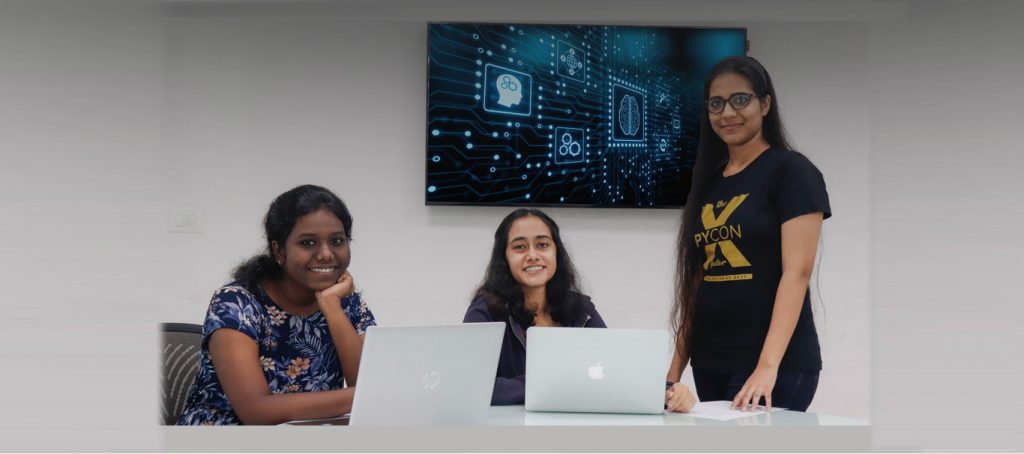
WiMLDS Amaravati Chapter at SRM AP founders: Sowjanya Naidu Nelli, Abirami Ravishankar and Aakanksha Chouhan
The Amaravati chapter of WiMLDS will work out of the SRM AP campus to provide support and promote women and gender minorities from the entire Amaravati region who are practicing, studying or interested in the field of machine learning and data science. The Amaravati chapter has the added distinction of having the youngest founding members of the worldwide WiMLDS network.
Abirami believes this initiative is important for several reasons, “Empowering women particularly from our region to pursue ML and AI irrespective of their tech/non-tech background, encourages diversity, economic growth, and equality across socio-economic backgrounds.”
WiMLDS has chapters in North America, Africa, Middle East, Europe, South Africa, Asia and Australia. The Amaravati chapter at SRM AP is the newest one in India.
“This organization (chapter) is looking to create opportunities for members to engage in technical and professional conversations in a positive, supportive environment by hosting talks by women and gender minority individuals working in data science or machine learning, as well as hosting technical workshops, networking events and hackathons.” says founder Aakanksha Chouhan.
The fields of Machine Learning and Data Science are growing exponentially both in real life applications and in academia. “Nature has always incentivized the human race when we observe accurate patterns in it,” says Sowjanya, “We used to call it ‘predictions’ till the 1950’s; now it goes by the name of Machine learning and Data Science.”
Aakanksha learned of this WiMLDS at PyCon Italy. “There I met members of WiMLDS from the Poland and Paris chapters. Subsequently, through the mentors at Next Tech lab we got to participate in a live talk session on ‘Women in ML & DS” conducted by Shubhi Sareen of Google Hyderabad who is also a member of WiMLDS Delhi. This led to a conversation with Erin Ledell, founder WiMLDS organization and the Bay Area chapter head and the subject of Amaravati came up and soon this chapter was established.
According to Aakanksha, Machine learning and more appropriately AI is forcing us away from simple and repetitive tasks towards solving real life problems and incubating new ideas. “The shift from ‘if I can’ to ‘how I can’ is exciting! And we can agree that these wonderful communities that exist have contributed immensely to push the human race forward and I’m happy to see that – we’re innovating!”
http://wimlds.org/about-the-amaravati-team/
Twitter : WiMLDS_AMVT
Instagram : wimldsamaravati
Women in Machine Learning and Data Science – 2019 Inauguration WiMLDS – Amaravati Chapter
Full Text – Jessie Papatolicas address
Continue reading → - NARL lab facilities proposed for collaborative multi-disciplinary research September 25, 2019
7th September 2019: Visiting dignitary, Dr. T. Narayana Rao, Sr. Scientist at NARL (National Atmospheric Research Laboratory at Gadanki, Department of Space described the research facilities at the lab and how academia and SRM AP faculty can share these resources to advance their research projects.
According to Dr. Rao, NARL is studying the erroneous GPS signals often caused by atmospheric changes, “NARL scientists are working on studying the atmospheric conditions by deciphering these flawed GPS signals. This is a necessary step as the accuracy of the readings and interpretation is crucial to assess atmospheric pressure, humidity, weather conditions while sending signals to ISRO launch pads.”
With regard to the specific research facilities at NARL, Dr. Rao spoke of the world’s second-largest phased array radar, the sophisticated radio, optical and acoustic instruments. These resources at NARL as well as access to the high-performance computing system of 1.5 Petaflop provides opportunities for academicians, scientists, research scholars and students in different disciplines including physics, chemistry, electronics, computer science and environmental science. Prof. Ranjit Thapa, Department of Physics says, “High-performance computing system deployed by computational researchers can solve critical research problems such as ‘self-healing materials’, ‘catalyst for CO2 and N2 reduction’, and ‘high energy density organic materials’.”
Dr. Rao further spoke of possible faculty participation in combined research studies on the surface and upper atmosphere using advanced MST radar and Lidars. Prof. D. Narayana Rao, Pro-Vice Chancellor highlighted that the central facility of NARL, access to advanced resources and equipment, and opportunity to submit projects in the globally recognized platform validates the importance of carrying out collaborative research with NARL.
Continue reading → - “WOMEN’S EMPOWERMENT IS AN ISSUE THAT CROSSES ALL SOCIO ECONOMIC BOUNDARIES.” September 23, 2019
Speaking on the subject of women’s empowerment and gender biases in all walks of life, Member of Parliament, Meenakshi Lekhi made it a point to explain how the notion applies not only to those who have succeeded in specialised careers like space research.
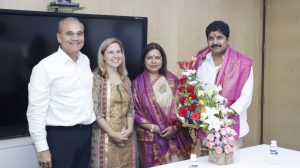 “Empowerment cannot be viewed from the narrow angle of haves and have nots. Women in power can also suffer from patriarchy. Empowerment means not having to depend on others, it is not linked to how one dresses or what one does for a living. It is about mental equality, knowing where you belong, how you express yourself, being self-assured, not letting external factors impede one’s growth and freedom.”
“Empowerment cannot be viewed from the narrow angle of haves and have nots. Women in power can also suffer from patriarchy. Empowerment means not having to depend on others, it is not linked to how one dresses or what one does for a living. It is about mental equality, knowing where you belong, how you express yourself, being self-assured, not letting external factors impede one’s growth and freedom.”On the subject of government programs that empower women directly (as individuals and responsible for their families), Ms. Lekhi drew the distinction between programs like ICDS (Integrated Child Development Services) and current programs like Ujjwala Yojana, Jan Dhan Yojna, Mudra Ayojana, and Awas Yojana where subsidies and financial assistance goes directly in the hands of women. “These programs demonstrate our trust in the capabilities of women to take care of themselves and their families. It is about helping the most vulnerable, providing help where it has not reached before.”
Continue reading →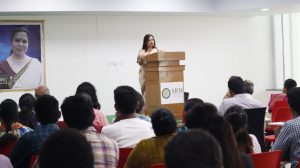 Ms. Lekhi is a Supreme Court of India lawyer. In July 2016, she was appointed as chairperson of the Committee on Privileges of the Lok Sabha in Parliament. She was awarded the “Best Debut Women Parliamentarian” award by Lokmat in 2017. She has led the debate on a wide variety of matters such as bails, trials, appeals, criminal writs, the Prevention of Corruption Act/Customs Act/FERA prosecutions, domestic violence and Family Law dispute. Lekhi has been a part of the Drafting Committees for Bills like “Women’s Reservation Bill” and “Sexual Harassment of Women at Workplace (Prevention, Prohibition and Redressal) Bill”. She also played an active role in the drafting of the Criminal Law (Amendment) Bill, 2013 which provided for amending the existing laws related to sexual violence. She has been in the National Commission for Women’s (NCW) special Committee, and Chairperson of Special Task Force on Women Empowerment Association.
Ms. Lekhi is a Supreme Court of India lawyer. In July 2016, she was appointed as chairperson of the Committee on Privileges of the Lok Sabha in Parliament. She was awarded the “Best Debut Women Parliamentarian” award by Lokmat in 2017. She has led the debate on a wide variety of matters such as bails, trials, appeals, criminal writs, the Prevention of Corruption Act/Customs Act/FERA prosecutions, domestic violence and Family Law dispute. Lekhi has been a part of the Drafting Committees for Bills like “Women’s Reservation Bill” and “Sexual Harassment of Women at Workplace (Prevention, Prohibition and Redressal) Bill”. She also played an active role in the drafting of the Criminal Law (Amendment) Bill, 2013 which provided for amending the existing laws related to sexual violence. She has been in the National Commission for Women’s (NCW) special Committee, and Chairperson of Special Task Force on Women Empowerment Association. - “Cost is the factor that connects all the dots.” Dr.Rajendran on the future of bioenergy September 7, 2019
“The Intergovernmental Panel on Climate Change (IPCC) suggests the temperature rise should be limited to 1.5°C by the end of this century for the world to survive, “says Dr. Karthik Rajendran, Assistant Professor, Department of Environmental Science. “For this, we need to reduce the emission by almost 50% of 2010 levels.” He further points out that while we may produce electric cars instead of petrol cars, electricity from solar and wind instead of coal, natural gas biologically as biogas instead of shale gas one question is at the center of these technologies – cost.
Dr. Rajendran’s quest to understand the factors influencing commercial viability of bioenergy systems began in Chennai during his bachelors’ thesis on hydrogen production leading subsequently to numerous lab simulations to understand the bottlenecks of commercialization.
On techno-economic analysis as an early indicator of commercial viability
Techno-economic analysis is an examination of various specifications of the technology at its inception stage when it is merely an experiment in a conical flask. “We analyze components on basis of all aspects of technology, economic feasibility, environmental sustainability, market realization and social integration. We can identify bottlenecks early on that hasten the technology out of the laboratory towards commercialization. This enables us to more accurately predict the fate of bioenergy/bio-based product developed out of laboratory.”
The role of institutional and government support
“In my Masters studies at UB Sweden I realized not all technologies being developed in labs are successful and that economics is not the only component that hinders commercialization. We need good institutional and governmental policy, including technical support, to advance such clean energy systems. This is when I started working on integrating technology, economics, and government policy. I compared different European technologies including biogas, electric cars, solar, and wind to understand the role of state/government subsidies towards green technology development. What I found was that electric car technologies for example do little to prevent C02 emissions, yet they receive more incentives from the government compared with other renewable energy systems. It’s about the source of electricity. Be it coal or wind plant if it’s not a green electricity source it is not a green vehicle.”
The science of energy waste conversion
Dr. Karthik Rajendran’s initial research on bioenergy production from waste looked specifically at hydrogen from algae. He currently focuses on bioenergy with carbon capture and utilization with the cost factor being the main parameter. Dr. Rajendran explains how this works. “For example, due to long term storage issues excess solar or wind energy spills over and is wasted. This excess electricity is converted to hydrogen through electrolysis. Then the hydrogen can be combined with CO2 from a bioenergy system to produce methane. This is known as Sabatier reaction. In Europe this research is happening with an aim to convert existing gas grids to a green gas grid by 2050.”
Several of Dr. Rajendran’s published papers examine electro fuels, circular bio economy and techno-economic analysis.
Continue reading → - SRM University, AP – Amaravati celebrates Founder’s Day September 4, 2019
Organises a Blood donation camp to honour Founder’s vision to serve the community
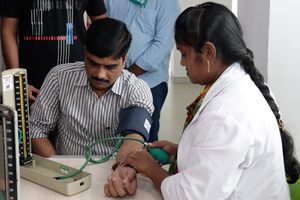
Amaravati, August 24th 2019: SRM University, AP – Amaravati celebrated Founder’s Day by organizing a blood donation camp. More than 120 college students and faculty have donated blood in the camp of which several were first time donors.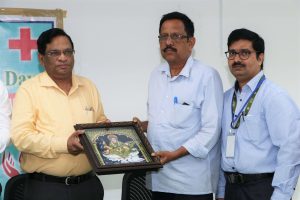 On this occasion, Prof. D. Narayana Rao, Pro Vice Chancellor, SRM University, AP-Amaravati presided over the program and shared the Founder and Chancellor, Hon’ble Member of Parliament, Dr. T.R. Paarivendhar’s vision and generous contributions to the society through various social services activities. “21 educational institutions have been established by SRM management under the leadership of Dr. Paarivendhar and till date around 1.10 lakhs students have passed out from different educational streams. Our Founder’s vision is to provide education to all and has therefore provided scholarships to the tune of Rs. 35 crore till date to the underprivileged sections of the society. The SRM institutions have more than 7,000 employees and 70,000 students currently.” shared Prof. Rao.
On this occasion, Prof. D. Narayana Rao, Pro Vice Chancellor, SRM University, AP-Amaravati presided over the program and shared the Founder and Chancellor, Hon’ble Member of Parliament, Dr. T.R. Paarivendhar’s vision and generous contributions to the society through various social services activities. “21 educational institutions have been established by SRM management under the leadership of Dr. Paarivendhar and till date around 1.10 lakhs students have passed out from different educational streams. Our Founder’s vision is to provide education to all and has therefore provided scholarships to the tune of Rs. 35 crore till date to the underprivileged sections of the society. The SRM institutions have more than 7,000 employees and 70,000 students currently.” shared Prof. Rao.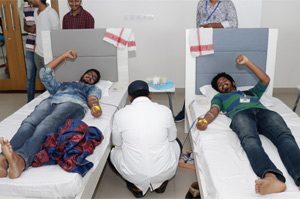 The University’s NSS division organised a blood donation camp together with the international Red Cross society. This was in line with the Founder’s vision to serve the community.
The University’s NSS division organised a blood donation camp together with the international Red Cross society. This was in line with the Founder’s vision to serve the community.“SRM Management is spending generously for the welfare of the underprivileged people.”, commented, D. Gunasekaran, Registrar, SRM University, AP – Amaravati. The Registrar also motivated and thanked the students by emphasising that blood donation is a big contribution towards the welfare of the society.
Dr. Lakshmi Rajyam, University Medical Officer, SRM University AP-Amaravati encouraged the students and staff to donate blood and explained, “A healthy body is capable of regenerating the blood donated in a few weeks’ time. India needs about 5 crore units of blood annually but has only 2.5 crore units available. This deficit can only be bridged if everyone comes forward to donate.”
Present for this celebration were – ProVC, Registrar, Deputy Registrar, University Medical Officer – Dr. Lakshmi Rajyam and Red Cross Guntur District incharge, Mr. Narasimha Rao along with faculty and students.
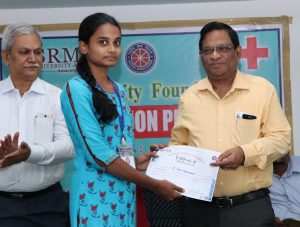 At this occasion, 20 NSS students were awarded certificates for their remarkable contributions to the community. The University got together and cut a cake to mark Founder’s Day.
At this occasion, 20 NSS students were awarded certificates for their remarkable contributions to the community. The University got together and cut a cake to mark Founder’s Day.Video Link: https://www.youtube.com/embed/ZHih6PGfI-0
Continue reading → - C Durga Rao September 3, 2019
- URC backs computational & experimental research. New R&D collaborations proposed August 27, 2019
Amaravati, 7th August 2019: At the University Research Council meeting held on campus, and presided by Dr. P. Sathyanarayanan, Founder and President of the board, a renewed commitment was made to research of national significance such as energy conservation and sustainability.
An illustrious, distinguished and accomplished group of academicians and scientists provided direction and mentorship to the faculty members and research scholars. The council comprises Prof K. Satyanarayana – Director, IIT Tirupati, Prof. U.B. Desai – Director, IIT Hyderabad, Prof. P. Appa Rao – Vice Chancellor, University of Hyderabad, Prof. Gautam R. Desiraju – IISc, Bangalore, Dr. S.R. Rao – former Senior Adviser, Department of Biotechnology, Government of India, Prof. B.S. Murthy – IIT Madras, Chennai, Dr. Padmanabham – Director, ARCI, Hyderabad, Prof. B.V.R. Chowdari – Senior Executive Director, Nanyang Technological University, Singapore and Prof. D. Narayana Rao – Pro-Vice Chancellor, SRM University – AP, Amaravati.
The meeting commenced with an opening presentation by Prof. D. Narayana Rao, Pro-Vice Chancellor, SRM AP, Amaravati highlighting the areas of research currently undertaken and proposed to carry out by the University’s 107-member faculty. The Chairman of the Research Council, Dr. V. K. Saraswat – Member of NITI Aayog, addressed all the members through a video call and advised them on the need and development of research activities. Dr. Saraswat also highlighted the importance of aligning research programs with the national agenda.
Vice Chancellor, Dr. Jamshed Bharucha emphasised SRM AP Amaravati’s focus on societal impact through original research in an interdisciplinary environment. The new research lab building and the X-Labs will facilitate these initiatives. Faculty Members made presentations on the current as well as proposed research activities
The council commended the quantum and quality of work already done by SRM AP Amaravati in just two years of inception. Members pointed out that the kind of MOUs and collaborations effected with different organisations are crucial for the faculty to be able to sustain research. Specific appreciation was about Hydrogen Powered Train (Jal-Janak Rail) being developed in collaboration with Integral Coach Factory (ICF) of the Ministry of Railways, SRM-Amara Raja Center for Energy Storage Devices. Special mention was made to the sports science centre as it is often an overlooked area.
Prof. P. Appa Rao offered that the experimental facilities of University of Hyderabad can be accessed by the faculty members of SRM University-AP, Amaravati. Dr. Padmanabham invited the faculty members of SRM University-AP, Amaravati to establish collaborations with ARCI, Hyderabad and make use of the state-of-the art experimental facilities available at ARCI.
Commenting on the occasion, Dr. Kasthurirangan Gopalakrishnan, Associate Dean – Research said, “The inputs provided by the council have not only been encouraging but have also been extremely insightful. They have provided diligent inputs and guidance. Our faculty found this experience extremely motivating.”
Continue reading →

